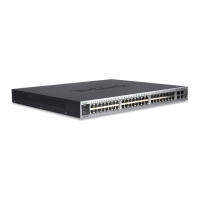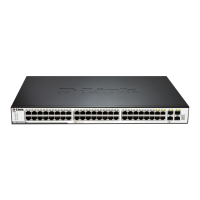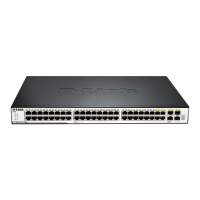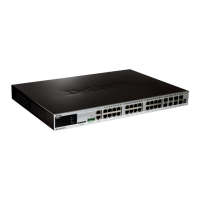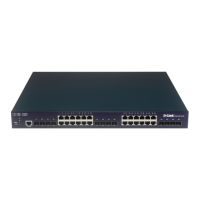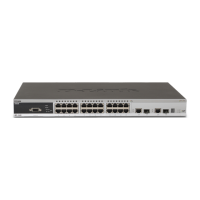xStack® DGS-3420 Series Layer 2+ Managed Stackable Gigabit Switch Hardware Installation Reference Guide
29
Chapter 4 Introduction to Switch Management
Management Options
Connecting the Console Port
Connecting to the Switch for the first time
Connecting to the Management Port
Password Protection
Assigning IP Addresses
SNMP Settings
Management Options
This system may be managed out-of-band through the console port on the front panel or in-band using Telnet. The user
may also choose the web-based management, accessible through a web browser.
Web-based Management Interface
After successfully installing the Switch, the user can configure the Switch, monitor the LED panel, and display statistics
graphically using a Web browser, such as Microsoft® Internet Explorer (version 5.5 and later), Netscape (version 8 and
later), Mozilla Firefox (version 2.0 and later), Safari (version 4.0 and later), and Google Chrome (version 6.0 and later).
SNMP-Based Management
The Switch is also managed with an SNMP-compatible console program. It supports SNMP version 1.0, 2.0 and 3.0. The
SNMP agent decodes the incoming SNMP messages and responds to requests with MIB objects stored in the database.
The SNMP agent updates the MIB objects to generate statistics and counters.
Command Line Interface Management through the Serial Port or remote Telnet
The user can also connect a computer or terminal to the serial console port to access the DGS-3420 range. The
command line interface provides complete access to all DGS-3420 Series of switches management features.
Connecting the Console Port
The console port on the front panel of the Switch is used to connect a computer that monitors and configures the switch.
The console port is an RJ-45 port and requires a special cable that is included with the switch, to establish the physical
connection.
To use the console port, the following equipment is needed:
• A terminal or a computer with both an RS-232 serial port and the ability to emulate a terminal.
• A console cable with a male DB-9 connector on one end and an RJ-45 connection on the other. This cable should
be included with any of the DGS-3420 Series. It establishes the physical connection to the console port.
To connect a terminal to the console port:
Connect the male DB-9 connector on the console cable (shipped with the DGS-3420-28SC for example) to the RS-232
serial port on the computer running terminal emulation software then insert the RJ-45 connector into the RJ-45 console
port on the front of the switch. Set the terminal emulation software as follows:
• Select the appropriate serial port (COM port 1 or COM port 2).
• Set the data rate to 115200 baud.
• Set the data format to 8 data bits, 1 stop bit, and no parity.
• Set flow control to None.
• Under Properties, select VT100 for Emulation mode.
